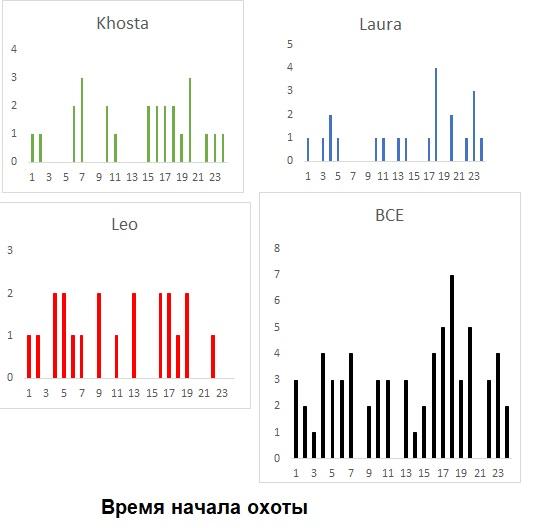Leopards released in July 2022 in the Republic of North Ossetia continue to explore the Central Caucasus. Having traveled most of the territory of North Ossetia, they headed west: the male Leo and female Laura left for Kabardino-Balkaria and, judging by the data we receive, are adapting well. The process of habitat formation is entering a new phase; it is too early to talk about their stabilization. The female Hosta remains faithful to the Ossetian mountains, now exploring the southern direction.
The results of processing data from GPS-collars, the coordinates from which we regularly receive, confirm that Khosta remains a record-breaking traveler - since her release she has already walked 991 km across the mountain slopes, foothills and low forests of Ossetia. The area mastered by her, in which she freely navigates, is now 1592 square kilometers: it covers Digorsky and Alagirsky districts and the district of Vladikavkaz. In spite of her attachment to forested gorges and red deer (she successfully hunted them in Tsey Reserve), Khosta decided to visit the southern part of the North-Ossetian Reserve and continues moving in the direction of the NP Alania. As she moves south, her preference for low forests changes to heights of about 1000-1500 m. Approximately every 100 km Khosta climbs a peak or ridge to have a good look around. The highest elevation to which she climbed was 2,488 m, all other climbs were limited to 2,000 m above sea level. During the "winter period" Khosta has already covered a greater distance than during the snow-free period - 562 and 429 km, respectively. The leopard is in excellent shape, as evidenced by the data we received from the camera traps. She feeds regularly and in abundance. So far we have checked 27 places where Khosta hunted. In spite of the fact that her diet consists primarily of small prey (badgers, jackals, raccoon dogs), she successfully hunted wild ungulates (deer, roe deer).
On January 9, 2023, Leo crossed the border of Ossetia and Kabardino-Balkaria, at the same time conquering a height of 3200 m above sea level. So far, he has chosen to explore the highest mountains of all leopards released in the Central Caucasus. In Kabardino-Balkaria, Leo prefers wild boars as winter food (he has already caught at least 5 wild boars in a month). It cannot be said that he traveled a lot in Kabardino-Balkaria - during the time spent there, he walked only 130 km and mastered a space of 116 sq. km, while he walked 548 km through the territory of Ossetia, and the area that he mastered there was 796 sq. km. In general, Leo prefers the path of least resistance: apart from climbing above 3,000 m a.s.l., he prefers altitudes no more than 1,000 m a.s.l. According to the data from the camera traps, Leo feeds very well (Fig. 1).
Laura showed interest for Kabardino-Balkaria twice. The first time she crossed the border before the new year (December 24, 2022), after which she returned to Ossetia (January 24, 2023), and the second time she left for Kabardino-Balkaria on January 29, where she remains to this day. Interestingly, Laura used the same ecological corridor for the transition from Ossetia to Kabardino-Balkaria which was once used by the female Volna, released in Ossetia in 2018. Laura did not meet Leo, despite the fact that she was moving from the north to the south, and Leo, after conquering the heights in the south, on the contrary, went north. At this time, there were moments when the cats were relatively close to each other (they were separated by no more than 4-5 km), but there was still no face-to-face meeting. Laura traveled 268 km through the territory of Kabardino-Balkaria and mastered an area of almost 400 sq. km, while in Ossetia her total track was 548 km, and the area was 652 sq. km. Among her latest prey are three wild boars, a raccoon dog and a wild Caucasian forest cat. It should be noted that Laura explores valleys and slopes most carefully, keeping a long distance from settlements - she never came closer than 3 km to them. At the moment there is no direct capture from camera traps, but there is no doubt that Laura is healthy and able, otherwise she would not have hunted for difficult prey like wild boars so successfully.
The program for the restoration (reintroduction) of the Caucasian (Persian) leopard in the Caucasus is being implemented by the Ministry of Natural Resources of Russia with the participation of the Sochi National Park, the Caucasian Reserve, the North Ossetian Reserve, the World Fund for Nature, the A.N. Severtsov Institute of Ecology and Evolution RAS, A.K. Tembotov Institute of Ecology of Mountain Territories RAS, Moscow Zoo, as well as with the assistance of the International Union for Conservation of Nature (IUCN) and the European Association of Zoos and Aquariums (EAZA). Financing of the monitoring of the Persian leopard in the Caucasus is funded by supporters of the World Fund for Nature, business companies RusHydro and EcoEnergy.



For successful hunting, all three leopards prefer twilight and hunt mainly at dusk (Fig. 3).

